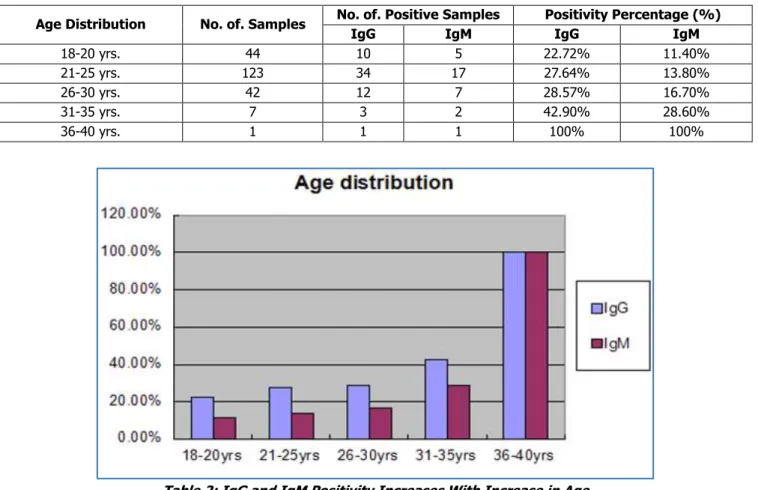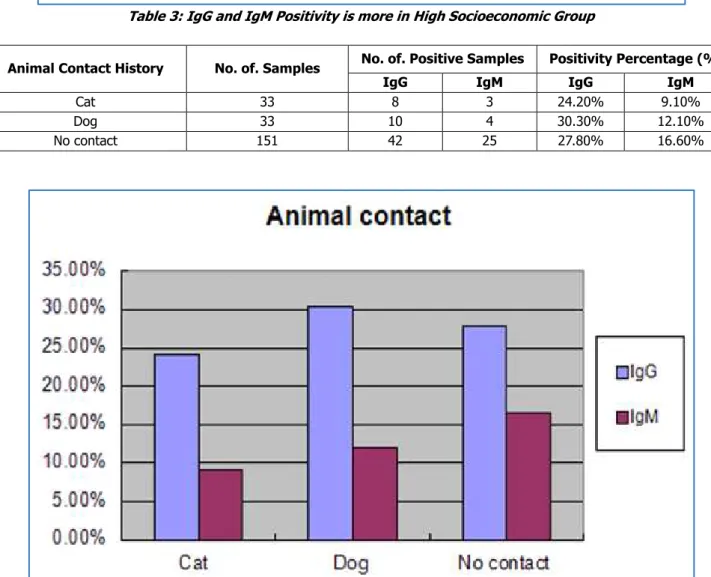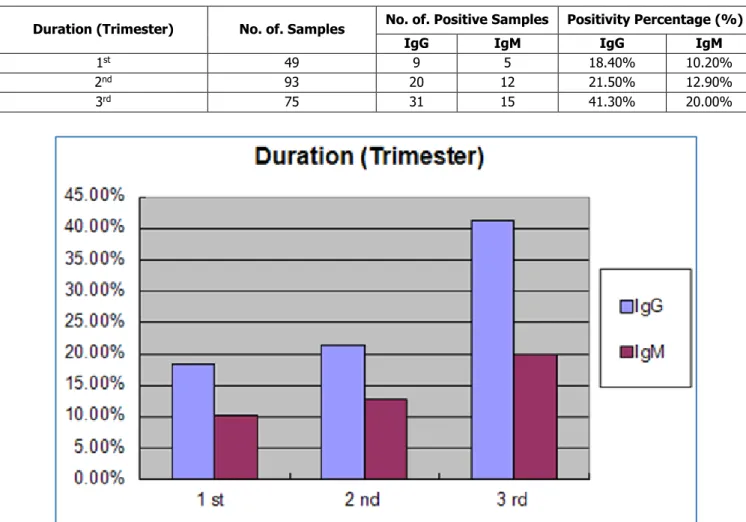J. Evid. Based Med. Healthc., pISSN- 2349-2562, eISSN- 2349-2570/ Vol. 3/Issue 68/Aug. 25, 2016 Page 3689
PREVALENCE OF TOXOPLASMOSIS IN PREGNANT WOMEN AND ITS CLINICAL
CORRELATION
Bhaskar Das1, Anant Dattatray Urhekar2, Neha Singh3, Harapriya Kar4
1Senior Resident, Department of Microbiology, M.G.M. Medical College, Navi Mumbai. 2HOD, Department of Microbiology, M.G.M. Medical College, Navi Mumbai.
3Junior Resident, Department of Microbiology, M.G.M. Medical College, Navi Mumbai. 4Assistant Professor, Department of Microbiology, M.G.M. Medical College, Navi Mumbai.
ABSTRACT
CONTEXT
Toxoplasmosis is one of the cause of abortion in pregnant women. Transplacental passage of the parasite from infected mother to the child may present with blindness, neurological impairment and mental retardation in congenital toxoplasmosis. Serological screening of pregnant women for Toxoplasmosis is very important to rule out causes of abortion and congenital malformation.
AIM
To analyse the prevalence of Toxoplasmosis by evaluating Toxoplasma IgG and IgM antibodies and correlating with age and trimester of pregnancy and other predisposing factors like h/o animal contact and socioeconomic status of the pregnant women attending antenatal clinic.
SETTINGS & DESIGN
Prospective study.
MATERIAL & METHODS
Serum samples were collected from 217 pregnant women without any h/o abortion, attending antenatal clinic along with epidemiological data. ELISA test for IgG and IgM Toxoplasma antibodies done with serum samples. The study carried out over a period of two years from October 2011 to September 2013.
STATISTICAL ANALYSIS
The Chi-square test was used to evaluate the association between age, trimester of pregnancy, animal contact history and socioeconomic status.
RESULTS
Toxoplasma IgG prevalence was 27.7% and that of IgM was 14.8%. The distribution showed increase of IgG and IgM positivity with increases in age and trimester of pregnancy. Both IgG and IgM positivity is associated with high socioeconomic group and with h/o contact with dog.
CONCLUSION
Toxoplasmosis prevalence is quite high and associated with predisposing factors. Early detection in pregnant women can reduce the severity of the disease.
KEYWORDS
Toxoplasmosis, Hydrocephalus, Microcephaly, Congenital Toxoplasmosis.
HOW TO CITE THIS ARTICLE: Das B, Urhekar AD, Singh N, et al. Prevalence of toxoplasmosis in pregnant women and its
clinical correlation. J. Evid. Based Med. Healthc. 2016; 3(68), 3689-3693. DOI: 10.18410/jebmh/2016/791
INTRODUCTION: Toxoplasmosis is caused by coccidian
parasite Toxoplasma gondii.(1) The route of transmission
are-ingestion of food or water contaminated with oocysts shed by cats, by eating meat containing infective tissue cysts and via transplacental transfer, when mother becomes infected for the first time during pregnancy.(2)
It can cause mortality in developing foetus if the mother acquires acute infection during pregnancy. Transmission rate to foetus increases from 15-65% with increasing gestational age. However, severity of congenital disease decreases with increasing gestational age.(3) The spectrum
of outcome of congenital toxoplasmosis ranges from subclinical infection to intrauterine death. There may be damage to central nervous system (Cerebral Calcification, Hydrocephalus, Microcephaly), choroidoretinitis, low birth weight etc. Children who are apparently normal at birth may develop the disease later in life.(4,5) Seroprevalence average
of Toxoplasma gondii infection in India has been reported to be 24.3%, lowest being in the northern part of India and Financial or Other, Competing Interest: None.
Submission 25-07-2016, Peer Review 12-08-2016, Acceptance 21-08-2016, Published 25-08-2016. Corresponding Author:
Dr. Bhaskar Das,
No. D1, 807, Summer Palm Society, Sector- 86, Faridabad-121001, Haryana.
J. Evid. Based Med. Healthc., pISSN- 2349-2562, eISSN- 2349-2570/ Vol. 3/Issue 68/Aug. 25, 2016 Page 3690 highest in the south and seroconversion rate of 1.5% has
been reported. On account of diversity or absence of symptoms, the detection of toxoplasma infection during pregnancy is made by serological procedures.(3)
MATERIAL AND METHODS: The study was a prospective
study carried out in the Department of Microbiology, MGM Medical College, Kamothe, Navi Mumbai over a period of two years from October 2011 to September 2013. Blood samples were collected from pregnant women attending antenatal clinic and patients admitted in antenatal ward of the hospital after taking written informed consent to perform ELISA Test for Toxoplasma IgG and IgM (Kit-RD-Ratio Diagnostics, Germany) on the serum samples. A predefined proforma was used to collect the data regarding age of the patient, gestational age (trimester) and predisposing factors like animal contacts and socioeconomic status. The result of ELISA Test was then subjected to statistical analysis.
RESULTS: A total of 217 cases of pregnant women without
any h/o previous abortion were evaluated. The prevalence of IgG positivity was 27.7% and that of IgM positivity was 14.8% (Table 1). The age group distribution has shown that the prevalence of IgG positivity increases from 22.72 to 100% and that of IgM positivity increases from 11.40 to 100% with increasing age (Table 2). The distribution of socioeconomic status shows that the prevalence of IgG positivity is more in high socioeconomic group (34.2%) and similarly IgM positivity is also more in high socioeconomic group (23.7%) (Table 3).
Again the IgG positivity is more in patients with h/o contact with dog (30.3%) as compared to cat (24.2%). Similarly the IgM positivity is more in case of h/o contact with dog (12.1%) than cat (9.1%) (Table 4). The prevalence of IgG increases with increases in duration of pregnancy (trimester) (18.4 to 41.3%). Similarly, prevalence of IgM increases with increase in trimester (10.2 to 20.0%) (Table 5).
Antibody No. of
Samples
No. of Positive Samples
Positivity Percentage
(%)
IgG 217 60 27.7 %
IgM 217 32 14.8 %
Table 1: IgG positivity is 27.7% and IgM positivity is 14.8%
Age Distribution No. of. Samples No. of. Positive Samples Positivity Percentage (%)
IgG IgM IgG IgM
18-20 yrs. 44 10 5 22.72% 11.40%
21-25 yrs. 123 34 17 27.64% 13.80%
26-30 yrs. 42 12 7 28.57% 16.70%
31-35 yrs. 7 3 2 42.90% 28.60%
36-40 yrs. 1 1 1 100% 100%
J. Evid. Based Med. Healthc., pISSN- 2349-2562, eISSN- 2349-2570/ Vol. 3/Issue 68/Aug. 25, 2016 Page 3691
Socioeconomic Status No. of Samples No. of Positive samples Positivity Percentage (%)
IgG IgM IgG IgM
High 38 13 9 34.20% 23.70%
Low 138 40 18 29.00% 13.00%
Middle 41 7 5 17.10% 12.20%
Table 3: IgG and IgM Positivity is more in High Socioeconomic Group
Animal Contact History No. of. Samples No. of. Positive Samples Positivity Percentage (%)
IgG IgM IgG IgM
Cat 33 8 3 24.20% 9.10%
Dog 33 10 4 30.30% 12.10%
No contact 151 42 25 27.80% 16.60%
J. Evid. Based Med. Healthc., pISSN- 2349-2562, eISSN- 2349-2570/ Vol. 3/Issue 68/Aug. 25, 2016 Page 3692
Duration (Trimester) No. of. Samples No. of. Positive Samples Positivity Percentage (%)
IgG IgM IgG IgM
1st 49 9 5 18.40% 10.20%
2nd 93 20 12 21.50% 12.90%
3rd 75 31 15 41.30% 20.00%
Table 5: IgG and IgM Positivity Increases with Increase in Trimester of Pregnancy
DISCUSSIONS: The prevalence of IgG positivity was
27.7% and that of IgM positivity was 14.8%. The geographical distribution of prevalence of Toxoplasmosis in pregnant women has been evaluated by other authors. In Eastern part of India, like in Kolkata the prevalence of IgG in primigravida is 45% and that of IgM in primigravida is 17.5% (Pal S et al6). In Assam, the prevalence of IgG in
normal pregnant women is 36.8% and prevalence of IgM is 5.9% (Borkakoty B J et al7). In northern part of India, like in
Kashmir prevalence of IgG is 27% and that of IgM is 1.12% (Ahmed QI et al8). In Chandigarh, prevalence of IgG is
15.33% and that of IgM is 3% (Khurana S et al3). In Delhi,
prevalence of IgG is 45% and that of IgM is 3.3% (Singh S et al9). In our study, the IgG prevalence corresponds with
other studies but IgM prevalence is slightly higher. In our study, the IgG and IgM positivity increases with increasing age, which may be due to repeated exposure to the infection source. There are similar studies of age group distribution like Borkakoty B J et al,(7) showed higher prevalence of T.
gondii infection was associated with increase in age. According to Mousa D A et al(10), there was increase in IgG
seropositivity with increase in age. In a study by Das Sarkar M et al,(11) there was increase in seropositivity with
advancing age. The seropositivity rate varied from 25% to 60.71% in the study group and from 0% to 17.64% in the control group. Mittal V et al(12) showed higher prevalence in
case of women aged 36 yrs. and above.
In our study, the seroprevalence of IgG and IgM is more in high socioeconomic group. A similar study by Berno M et al(13) showed higher prevalence of Toxoplasmosis in high
socioeconomic group (SEG) as compared to low SEG. Chintapalli S et al(14) documented high IgG seropositivity
(83.87%) in LSG and high IgM seropositivity (80.0%) in HSG. In our study, the seroprevalence of IgG and IgM is more in patients with h/o contact with dog as compared to cat as pet animal. Similar to our studies, Susan S et al(15)
showed an association of dogs, rather than cats with T. gondii infection. In our study, the seroprevalence of IgG and IgM increases with increasing duration of pregnancy (Trimester). A study by Ahmed Q I et al(8) documented 47
cases of primary toxoplasmosis out of 138 cases in first trimester, 40 cases in second trimester and 51 cases in third trimester. Deji-Agaboola A M et al(16) observed high
J. Evid. Based Med. Healthc., pISSN- 2349-2562, eISSN- 2349-2570/ Vol. 3/Issue 68/Aug. 25, 2016 Page 3693
ACKNOWLEDGEMENT: It is a privilege on my part to
express my gratitude to Dr. A. D. Urhekar, (Head of Dept.), Dr. Harapriya Kar (Assistant Professor) and other teaching staff of Department of Microbiology, MGM Medical College, Navi Mumbai for their guidance and advice to complete this work.
REFERENCES
1. Chatterjee KD. Parasitology, protozoology and
helminthology. 13th edn. New Delhi: CBS Publishers
2008:129-133.
2. Abu-Madi MA, Al-Molaw N, Behnke JM.
Seroprevalence and epidemiological correlates of toxoplasma gondii infections among patients referred for hospital based serological testing in Doha, Qatar. Parasites and Vectors 2008;1:39.
3. Khurana S, Bagga R, Aggarwal A, et al. Serological screening for antenatal toxoplasma infection in India.
Indian Journal of Medical Microbiology
2010;28(2):143-146.
4. Robert-Gnansia E. Congenital toxoplasmosis.
Orphanet Encyclopedia. October 2013.
(http://www.orpha.net/data/patho/GB/uk-toxo) 5. Neto EC, Roselia R, Jaqueline S, et al. Newborn
screening for congenital infectious diseases.
Emerging Infectious Disease 2004;10(6):1069-1073. 6. Pal S, Das N, Pal D. Sero-prevalence and risk factors
of toxoplasma gondii in pregnant women in Kolkata, India. Journal of Recent Advances in Applied Sciences 2011;26(1-2):27-33.
7. Borkakoty BJ, Borthakur AK, Gohain M. Prevalence of
toxoplasma gondii infection amongst pregnant women in Assam, India. Indian Journal of Medical Microbiology 2007;25(4):431-432.
8. Ahmed QI, Choh SA, Charoo BA, et al.
Clinicoepidemiological profile of maternal and congenital toxoplasmosis in Kashmir valley: a hospital based study. Journal of Pediatric Infectious Diseases 2010;5(4):333-337.
9. Singh S, Pandit AJ. Incidence and prevalence of toxoplasmosis in Indian pregnant women: a prospective study. American Journal of Reproductive Immunology 2004;52(4):276-283.
10. Mousa DA, Mohammad MA, Toboli AB. Toxoplasma
gondii infection in pregnant women with previous adverse pregnancy outcome. Medical Journal of Islamic World Academy of Sciences 2011;19(2):95-102.
11. Sarkar MD, Anuradha B, Sharma N, et al.
Seropositivity of toxoplasmosis in antenatal women with bad obstetric history in a tertiary-care hospital of Andhra Pradesh. India. Journal of Health Population and Nutrition 2012;30(1):87-92.
12. Mittal V, Bhatia R, Singh VK, et al. Prevalence of toxoplasmosis in Indian women of child bearing age. Indian Journal of Pathology and Microbiology 1995;38(2):143-145.
13. Mwambe B, Mshana SE, Kidenya BR, et al. Sero-prevalence and factors associated with Toxoplasma gondii infection among pregnant women attending antenatal care in Mwanza, Tanzania. Parasites & Vectors, 2013;6:222.
14. Chintapalli S, Padmaja IJ. Seroprevalence of
toxoplasmosis in antenatal women with bad obstetric history. Tropical Parasitology 2013;3(1):62-66. 15. SrokaS, BartelheimerN, WinterA, et al. Prevalence
and risk factors of toxoplasmosis among pregnant women in Fortaleza, Northeastern Brazil. The American Jourrnal of Tropical Medicine and Hygeine 2010;83(3):528-533.


